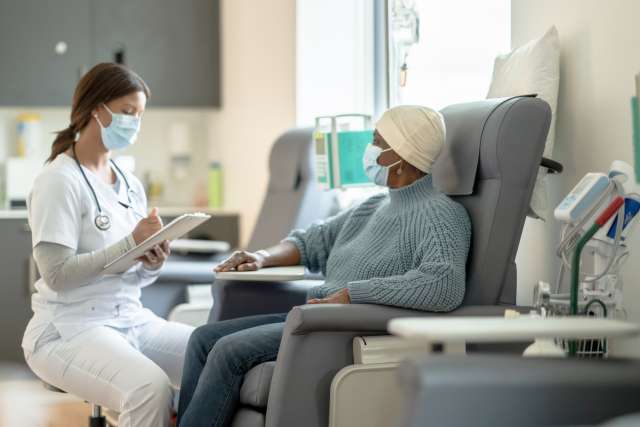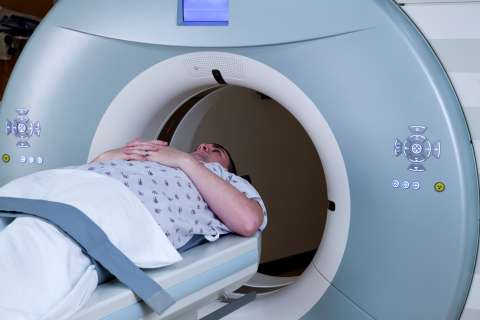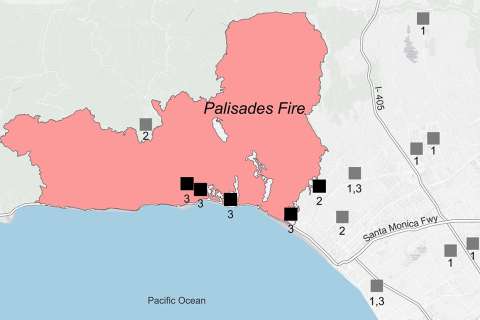Research led by scientists at UCLA Jonsson Comprehensive Cancer Center found that responses to a type of immunotherapy called PD-1 checkpoint blockade in patients with advanced melanoma depended on whether or not they had previously received another immunotherapy – CTLA-4 blockade – as well as other factors.
Their findings, based on analysis of seven data sets generated over the past decade, which included results of tumor biopsies from more than 500 patients, are published in Cancer Cell.
“In our large set of data, features that have been used to predict response to anti-PD-1 checkpoint blockade therapy – often called biomarkers –related to the presence of certain immune cell types in the tumor and the genetic profile of the tumors themselves were modified by a patient’s treatment history,” said lead author Katie Campbell, PhD, a postdoctoral fellow in hematology/oncology at UCLA Jonsson Comprehensive Cancer Center.
When a patient is diagnosed with advanced melanoma, they usually are treated with immune therapies like anti-PD-1 blockade and anti-CTLA-4 blockade, in combination or alone. By blocking different proteins that diminish the effectiveness of T cells, these checkpoint inhibitors enhance the body’s immune response to cancer.
“As translational scientists, when we work with clinicians, one of the goals is to think about how biomarkers can be used to inform clinical benefit. If we can predict which patients are or are not going to respond to therapy from studying their biopsies, we can start to more strategically define which therapies or combinations of therapies should be used and when,”
“Since the current treatment paradigm for melanoma involves combinations or sequential use of immune checkpoint therapies, our study supports how these therapies may work together to effectively treat melanoma. It also highlights the importance of a patient’s prior treatment history as a modifying factor to consider when planning a treatment strategy,” said co-senior author Dr. Antoni Ribas, director of the Tumor Immunology Program at UCLA Jonsson Comprehensive Cancer Center and the Parker Institute for Cancer Immunotherapy Center at UCLA.
Although immunotherapy is becoming increasingly common in treating late-stage cancers, most studies on biomarkers and factors determining effectiveness are based on small series of samples. Therefore, the multidisciplinary and multicenter research team set out to assemble and harmonize a large set of tumor and clinical data from patients with melanoma to identify key factors associated with treatment response.
“The cohesive processing of clinical data sets requires collaboration among experts with knowledge in computer science, statistics, biology, immunotherapy, informatics, and translational and clinical medicine. We undertook this project to establish a resource for other researchers, with the goal of identifying statistically significant correlates of melanoma responses to anti-PD-1 therapy,” Campbell said.
“As we performed the analyses, the greatest differences were seen when we accounted for a patient’s prior treatment with anti-CTLA-4 blockade,” she added. “the context in which a biopsy is collected needs to be considered to better define how biomarkers should be implemented in the clinical setting.”
The researchers said that by processing the DNA and RNA sequencing data from hundreds of patients on one cohesive pipeline, they were able to control for some of the wide range of differences that exist across patients, tumors and treatment histories. They also considered clinical demographics that may be important for understanding why a patient did or did not respond to anti-PD-1 blockade therapy.
Although the results do not specifically explain how or when to clinically apply the biomarker information, they provide a foundation and a road map.
AUTHORS
In addition to lead author Campbell and co-senior author Ribas, both of whom are corresponding authors, co-senior authors include Christine Spencer and Daniel Wells from the Parker Institute for Cancer Immunotherapy in San Francisco. Campbell cooperatively led this study with Meelad Amouzgar, from Stanford University and the Parker Institute for Cancer Immunotherapy. The complete list of contributing authors and institutions is included with the published article.
ACKNOWLEDGMENTS
The authors would like to acknowledge Bristol Myers Squibb and the REVIVE program at the Parker Institute for supporting this study through both the contribution of previously unpublished data and funding support. This study is an example of the power of collaboration between academic medical centers (UCLA), non-profit research institutions (PICI) and biopharma (BMS) to bring benefit to patients.
FUNDING
Several authors receive grants from the National Institutes of Health, including the National Cancer Institute. Ribas is supported by NIH grants R35 CA197633 and P01 CA167575, the Parker Institute for Cancer Immunotherapy, and the Ressler Family Fund. He also receives support from Ken and Donna Schultz, and Thomas Stutz. Campbell is supported by the Cancer Research Institute Irvington Postdoctoral Fellowship Program, the V Foundation Gil Nickel Melanoma Research Fellowship, and the Parker Institute for Cancer Immunotherapy (PICI) and V Foundation Bridge Fellows Program. A full list of funding sources is provided with the article.
Authors’ competing interests are published with the Cancer Cell article.
Article: Prior anti-CTLA-4 therapy impacts molecular characteristics associated with anti-PD-1 response in advanced melanoma, Cancer Cell, Volume 41, Issue 4, 10 April 2023, Pages 791-806.e4, DOI: 10.1016/j.ccell.2023.03.010




